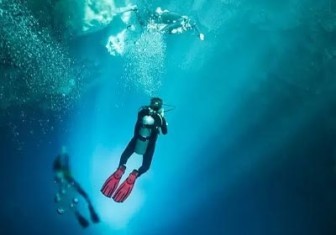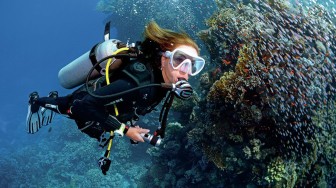Diving Sites in Port Blair




-
Jul 29, 2022
Birds of Andaman and Nicobar
The Indian archipelago of Andaman and Nicobar Island is considered a paradise for Biological Diversity. About 8452 species of fauna are marked in this area, of which 846 are endemic to these islands. Around 280 species of birds were found in Andaman and Nicobar Islands belonging to 56 families under 17 orders. Amongst the 280 species, 105 are endemic at species and subspecies levels and 142 bird species are of the Indian Subcontinent; of which 28 are found in Andaman and Nicobar Islands.
Though these islands form only 0.25% of the landmass of India, they support a whopping 12% of the endemic avifauna.
The Andaman and Nicobar Islands are one of the 218 Endemic Bird Areas of the world, which was identified by Birdlife International. These islands definitely house the most beautiful, striking and sparking species of birds. Let us read about some of the most famous ones in this archipelago.
Andaman is also considered a bird-watching paradise, people visit the sanctuaries here to get closer to nature and observe the beautiful show put up by the avifauna here.
Andaman Green Pigeon
These birds are usually found singly or in small groups. These are medium-sized pigeons, with a greenish yellow head and green underparts. The under-tail coverts are mostly whitish pale yellow in colour with red legs. They can be seen in evergreen
forests and edges; while they munch on the seeds and fruits of a wide variety of plants.
Andaman White-Headed Starling
They are found across Andaman mainly in the forest clearings and edges, farmlands,
plantations, beaches and grass. These creatures have cream white underparts, while their wings are glossy and greenish-black.
Andaman Drongo
Mainly found in the Andaman Islands and evergreen forests, these birds have deeply forked tails, a heavy black bill and black and glossed green plumage.
Andaman Bulbul
This bird is endemic to the group of Islands. They have an olive plumage and most of their head is olive. These birds can be commonly found in forests, forest edges and thick jungles. They depend on small fruits, berries and insects.
Andaman Cuckoo-Dove
These doves are found in dense, board-leaf, primary and secondary forests. Andaman Cuckoo-Dove is frugivorous and feeds on a variety of fruits and berries. These are endemic to Andaman and Nicobar Islands.
Andaman Hawk-Owl
Found in the lowland forest with occurrence in a low secondary forest as well as mangrove forest, settlements, plantations, lightly wooded areas and forest clearings are usually seen hawking on insects at dusk.
Andaman Teal
These are the species of small duck found on the Andaman Islands. The Andaman Teal is dark brown in colour with buffy markings. Their face and throat are pale with a white ring around the eye. They have a bluish-grey bill and a red iris. Found in the inland wets as well as mangroves and lagoons, they depend on molluscs and arthropods.
Andaman Serpent Eagle
This bird belongs to the Accipitridae family and is a species of bird of prey. The adult birds have dark brown underparts and underwings coverts with white spots. They can be commonly seen in the tropical moist lowland forests and tropical mangrove forests. They feed on frogs, lizards, snakes, birds and rats.
Andaman Coucal
These are found in forest-edge gardens, cultivation areas and mangrove areas and are endemic to these islands. They closely resemble the Greater Coucal, but here, their plumage is a fawn brown as opposed to C.sinensis’s which is bluish purple. These birds also have a chestnut rear mantle and wings and their head is pale tawny brown. Their mantle and breast grade from pale to dark brown on the belly and vent.
Andaman Wood pigeon
It is an uncommon species in the dense forest of this archipelago and is usually found in pairs or small parties. These birds are frugivorous and depend upon a variety of large berries and fruits. They also wander between islands in search of food sources, like the fruiting fig trees.
Nicobar Megapode
Found in the Nicobar Islands, the colour of this bird is rufous-brown with a short crest. The adults have bare reddish facial skin, lacking in juvenile. The legs of these birds are greenish-brown. These birds are locally common in coastal dry deciduous forests. They are a unique group of birds which incubate their eggs on mounts. Also called the ‘thermometer birds’ as they incubate their eggs in constructed mounts of rotting vegetation, which they manipulate in order to regulate the temperature.
Narcondam Hornbill
These birds are restricted and confined to Narcondam Island with an area of 6.82 square kilometers. It was discovered by A.O. Hume and was named after the island. These birds are interesting species from an ecological and evolutionary point of view and their population is stable over the years.
Nicobar Parakeet
Found mainly in the Nicobar group of Islands, the male creatures are yellowish green with buffish grey heads, black foreheads and road black chin stripe. They are generally found in tall trees in evergreen forests.
Andaman Treepie
These birds can be found throughout the Andamans, it is a long-tailed passerine species it belongs to the family Corvidae. They are generally found in pairs or parties in tall trees in dense broad-leaved evergreen forests, near the coast and on hill slopes.
Andaman Cuckooshire
They are medium-sized arboreal birds, which are generally long and slender. They are usually found singly or in pairs. The birds mainly feed on insects and also eat vertebrates, fruits, seeds and other plant material. These birds are mainly found on top
of trees.
Andaman Shama
Residents of Andamans, are similar to white-rumped Shama. They have a white belly and are fairly common in dense forest, scrub and gardens, especially in dense ravines near water.
Andaman Wood Pecker
These birds are found in the South and Middle surrounding islets of Andamans. They are black in colour and large in size, the male has a red crown and moustachial stripe. The woodpeckers are usually found in evergreen and open forests.
The endemic birds at subspecies levels are Common Hill-Myna, Andaman Black-crested Baza, Andaman Green Imperial-Pigeon, Andaman Collared Kingfisher, Andaman Red Breasted Parakeet, Andaman Little Green Heron and many more.
Diving Sites in Port Blair
Diving Sites in Havelock Island
Diving Sites in Neil Island
.jpg)
.jpg)


.jpg)